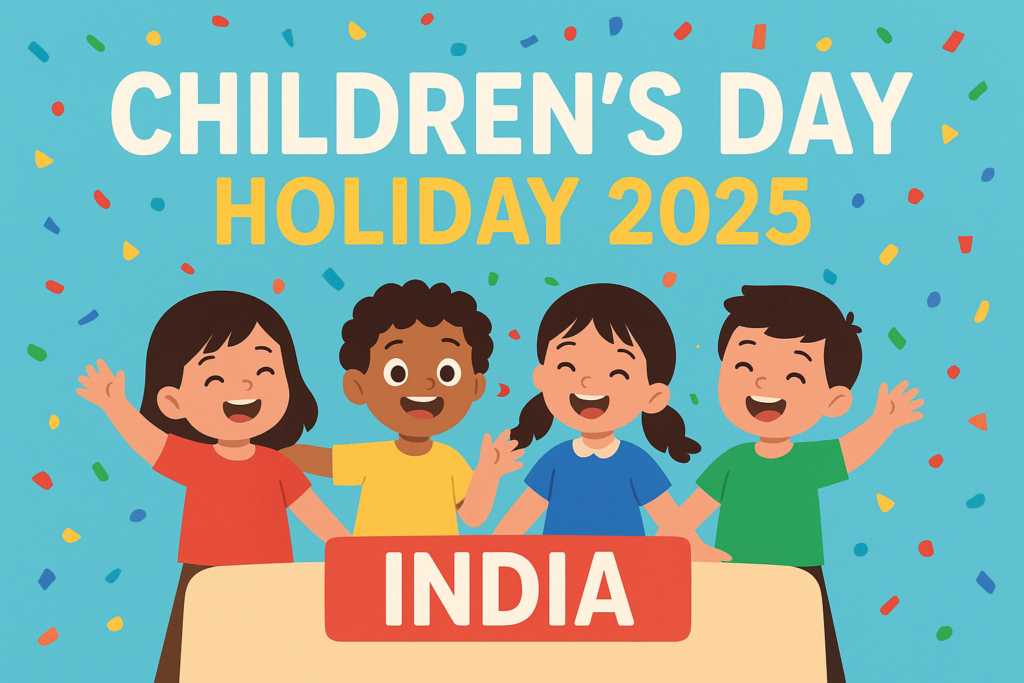Every year in India, the 14th of November holds a special place—it is celebrated as Children’s Day (also known as Bal Diwas) in honour of the birth anniversary of Jawaharlal Nehru, India’s first Prime Minister, who was widely loved by children and remembered for his affection toward them. This day is not merely about celebrations and fun—it is a reminder of our collective responsibility to care for children, safeguard their rights, and invest in their future.
Below is a table with forthcoming dates of Children’s Day in India for your planning convenience.
| Year | Date | Day of the Week |
|---|---|---|
| 2025 | November 14 | Friday |
| 2026 | November 14 | Saturday |
| 2027 | November 14 | Sunday |
| 2028 | November 14 | Tuesday |
| 2029 | November 14 | Wednesday |
- Historical Background of Children's Day
- Significance of Children’s Day
- How is Children’s Day Celebrated across India
- Themes and Evolving Focus
- Why It Matters – Deeper Reflection
- Practical Tips: Making Children’s Day Meaningful
- Challenges and Critiques
- Bringing It to Life: Real-World Stories
- Children’s Day in a Changing World
Historical Background of Children’s Day
a. The origin of Children’s Day in India
The idea of marking a special day for children in India has roots dating back to post-independence India. Before the present date, there were other occasions when children’s welfare was highlighted in different forms. In 1954, Children’s Day was officially designated as 14 November – the birthday of Nehru ji.
Why was 14 November chosen? Nehru’s affection for children earned him the nickname “Chacha Nehru” and he believed that children are the future of the nation; thus marking his birthday as a day for children seemed fitting.
b. Nehru’s vision & contribution
Nehru ji was a strong advocate of education and believed that nurturing young minds was foundational to nation-building. He supported institutions and policies aimed at child welfare, emphasising free primary education and equal opportunities for all children.
c. Why children? Why this day?
Children represent the future; society’s investment in children is investment in tomorrow. Celebrating Children’s Day aligns celebration with responsibility—recognising children, their rights, and encouraging their holistic growth. The day also raises awareness about issues such as child labour, education, health, nutrition.
Significance of Children’s Day
a. A tribute to childhood
Children’s Day emphasises the value of childhood—joy, innocence, creativity and the right to grow in a safe, supportive environment. The celebrations remind children and adults alike that the period of childhood must be preserved and respected.
b. Highlighting children’s rights and welfare
On this day, the focus is on ensuring that children get access to education, health, nutrition, and safe environments. It is an opportunity to reflect on where gaps exist and how they can be addressed.
c. Reinforcing the role of educators, parents and society
Children’s Day is also a call-to-action—schools, parents, governments and the community all share a part in nurturing children. It’s a day for special events in schools, discussions, awareness drives—bringing together stakeholders to commit to bettering children’s experiences.
How is Children’s Day Celebrated across India
a. Schools and educational institutions
Schools often take the lead. On 14 November, many schools organise cultural programmes, fun activities, competitions (drawing, essay, quiz), skits, dances, games, role-reversal events (teachers become students!) to mark the day with enthusiasm and meaning.
Also, many activities tie into awareness themes—children’s rights, inclusive education, mental health of children, etc. For example, the theme for 2025 is “For Every Child, Every Right”.
b. Community & government initiatives
Beyond schools, community organisations and NGOs use the day to hold special events: health check-ups, donations of books/toys, campaigns against child labour, emphasising education for all children, etc.
c. Families and children themselves
In homes, parents make the day special for their children—quality time, outings, fun activities, heartfelt conversations. It’s a chance to recognise the child’s inner world, dreams and aspirations—and to encourage them.
d. Symbolism and gestures
Often, speeches, assemblies, cultural shows have references to Nehru ji’s love for children, his vision. For example:
“The children of today will make the India of tomorrow. The way we bring them up will determine the future of the country.”
Themes and Evolving Focus
a. The 2025 theme
In 2025, the theme is “For Every Child, Every Right” – indicating a renewed focus on ensuring inclusive opportunities for all children, across socio-economic strata.
b. From fun to rights-based approach
Earlier, the celebrations were more about fun, enjoyment and recognising children. Over time, the emphasis has shifted also to structural issues—education, mental well-being, welfare, rights. Schools now often integrate discussions and reflections alongside the fun.
c. Key topics for focus
- Inclusive education: ensuring children with disabilities or from marginalised communities get access.
- Child health and nutrition: early childhood interventions, mid-day meals, health camps.
- Protection from exploitation: child labour, trafficking, abuse.
- Emotional and mental well-being of children.
These dimensions deepen the observance beyond mere festivity.
Why It Matters – Deeper Reflection
a. Children as architects of the future
Because children will grow up to shape societies, economies and nations, investing in them isn’t optional—it’s integral. Nehru’s vision emphasised this. Nehru ji once said the foundation of the country rests on its children.
b. Addressing systemic challenges
India still faces challenges in child welfare: gaps in education quality, child nutrition, child protection. Celebrating Children’s Day draws attention and helps galvanise action.
c. Creating a culture of respect for children
By giving children a special day, society sends a message—they matter. Their voices, rights, dreams matter. It helps cultivate respect for childhood and ensures children aren’t overlooked in policy and planning.
d. Empowering children with agency
Children’s Day encourages children to express themselves—through essays, drawings, performances. It provides a platform where they are heard and where their potential is recognised. This empowerment has cascading effects.
Practical Tips: Making Children’s Day Meaningful
Here are some ideas for educators, parents, and children themselves to mark this day in a way that combines joy with purpose.
a. For schools
- Plan a short assembly: include a talk on children’s rights & responsibilities.
- Organise fun competitions: draw your dream job, write a letter to your country’s future.
- Invite a guest speaker (child rights activist or local educator).
- Encourage role-swap: teachers act as students briefly, children share how they’d teach.
- Collect donations of books/toys for under-privileged children (voluntary).
- Use digital tools: ask children to do a virtual presentation on “I am the future”.
b. For parents
- Spend undistracted time with your child: ask about their dreams, worries, favourite things.
- Read together: a children’s rights book or right-based theme.
- Visit a local library or hold a mini-outing (park, museum, children’s event).
- Encourage your child to volunteer or contribute (age-appropriate) to other children’s welfare.
- Reinforce their agency: ask what they would like to do to make the world better.
c. For children
- Participate actively: volunteer for a school event, write or draw your vision.
- Talk to elders about what you want to become, what you want changed in the world.
- Recognise your rights: ask questions about your education, health, free-time.
- Be kind to friends, help younger children, share your time or toys.
- Dream big—Children’s Day is your day too.
Challenges and Critiques
a. Is it a holiday?
Interestingly, even though Children’s Day is widely observed, it is not necessarily a public holiday across India. Many schools remain open and hold events rather than giving a full day off. This means that although the date is recognized, normal routine often continues.
b. The gap between celebration and reality
While many children enjoy the day, for some children the underlying issues remain: poor access to schooling, malnutrition, neglect. The risk is that the day becomes superficial fun without meaningful follow-through. Ensuring long-term action is key.
c. Ensuring inclusivity
Celebrations must ensure they are inclusive—children with disabilities, children from marginalised or remote areas must be included. The theme for 2025 emphasises this but translating it into reality remains a challenge.
Bringing It to Life: Real-World Stories
a. School-level initiatives
In many schools across India, 14 November is a day of joyous celebration. Children dress in colourful clothes, take part in performances, teachers become audience and sometimes participants too. The essence is fun + reflection.
b. Community outreach
NGOs use this day to hold health check-ups, donate books and toys to needy children, run awareness drives about child rights and education. It becomes a mini-campaign day for children’s welfare.
c. The legacy of Nehru’s affection
The image of Nehru surrounded by children is iconic. He used to emphasise play, curiosity, educational value for children. His legacy remains embedded in this observance.
Children’s Day in a Changing World
a. Digital age children
With digital tools, children today have opportunities unknown before. On Children’s Day, digital‐themed events (coding games, digital storytelling) can be included to make the day relevant to modern childhood.
b. Pandemic & post-pandemic reality
The COVID-19 pandemic highlighted vulnerabilities—school closures, digital divide, mental health issues among children. On Children’s Day, reflections on these realities are important: ensuring every child has access to education, health, digital resources, emotional support.
c. Global perspective
While India celebrates Children’s Day on 14 November, globally other dates exist (for example, Universal Children’s Day on 20 November). This offers a chance to connect local celebrations with global child‐rights movements.
FAQs on Children’s Day
Q1. Is Children’s Day a national holiday in India?
Not always for every institution; many schools remain open and hold events rather than giving the full day off.
Q2. Why do we celebrate it on 14 November?
Because it is the birth anniversary of Jawaharlal Nehru, who was known for his love for children and belief in their importance to India’s future.
Q3. What is the theme for 2025?
“For Every Child, Every Right” – emphasising inclusive rights and opportunities for all children.
Q4. How can families make the day special?
By spending meaningful time with children, listening to their dreams, encouraging them, doing an act of kindness together, linking fun with purpose.
Q5. What responsibilities do schools/teachers have on this day?
They can use the day to engage children in meaningful conversations about their rights and dreams, plan inclusive and fun activities, and perhaps initiate new programmes for child welfare.



